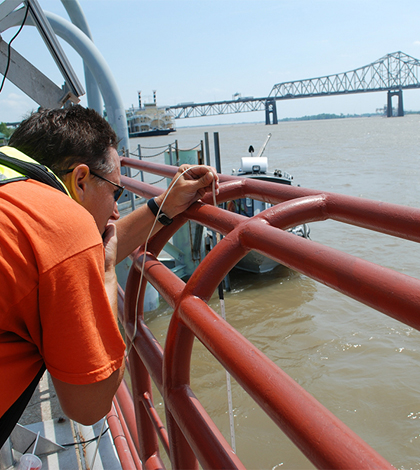Microbes in muddy Mississippi River more active than previously thought

USGS crews at the Baton Rouge Mississippi River gauging station (Credit: USGS)
Prevailing historic opinion among stream chemists has been that large turbid rivers like the Mississippi River don’t harbor much primary production.
“It’s just hard to imagine there being a lot of photosynthesis there because the light doesn’t make it very far in,” said Walter Dodds, professor of biology at Kansas State University.
But a study led by Dodds recently published in the journal Freshwater Science suggests that the river generates more primary production than people previously thought. The study estimated daily whole-ecosystem metabolism–the balance of gross primary production and community respiration–from two years of data on one site along the Mississippi. It is perhaps the first study of its kind on such a large river.
“We found some interesting stuff,” Dodds said. “There are times when the flow is lower and the water is a little bit clearer when primary production–even in this very large, turbid river–can be measurable and perhaps even important.”
Ecosystem metabolism estimates have become common for small rivers, but these kinds of analyses are still rare for large ones. One reason for that is that it’s easier for researchers on small streams to wrangle the physical dimensions necessary to run the models that estimate metabolism.
“If you need average depth and average width, you just wade and measure it,” Dodds said.
Those numbers are harder to get to on a river like the Mississippi, requiring researchers to make some assumptions and back calculations based on rating curves and discharge data from gauging stations operated by the U.S. Geological Survey.

The public dock on the Mississippi River at Baton Rouge that houses the USGS water quality station (Credit: USGS)
A deeper look at metabolism in large rivers has also been slowed by the mindset that these systems are just pipes that receive whatever flows into them and convey it directly to the ocean.
“But the realization that there’s quite a bit of in-stream processing as you move down through the system has led people to start thinking about where it’s happening, how great the rates are and how much of an impact it might have on things like water quality and the biological communities downstream,” Dodds said.
For their study of the Mississippi, Dodds and his colleagues relied on publicly available data for dissolved oxygen, photosynthetically active radiation and barometric pressure. Continuous dissolved oxygen data came from USGS sensors installed in the river’s main channel near Baton Rouge, La. PAR came from nearby U.S. Department of Agriculture stations, and pressure came from the Weather Underground.
The metabolism models showed that, over the course of a year, respiration in the Mississippi outweighs primary production, suggesting that metabolic activity in this stretch of the river relies on organic carbon flowing in from outside sources. But there seasonal episodes where primary production catches up with respiration, most likely driven by photosynthetic activity in shallow areas and side channels.

An aerial photo of the Mississippi where it flows through Baton Rouge (Credit: USGS)
Since outside sources of organic carbon appear to be an important food source for respiring microbes in the river, the study raises further questions of the effects of human alterations of the Mississippi that have cut off the river from riparian wetlands and tributaries. Those systems were once an important source of terrestrial carbon that the river’s microbes and animals that depend upon them now do without.
But without historic data to look at as a baseline, speculation over how the metabolism of the river has changed is mostly guesswork. What the researchers can say is that the processing activity of the organisms in the river is measurable and important.
“That’s the overall take-home message,” Dodds said. “Maybe it’s not that surprising, although not that many people have measured it. I don’t think anybody has measured it in a river that big.”
Top image: USGS crews at the Baton Rouge Mississippi River gauging station (Credit: USGS)




0 comments